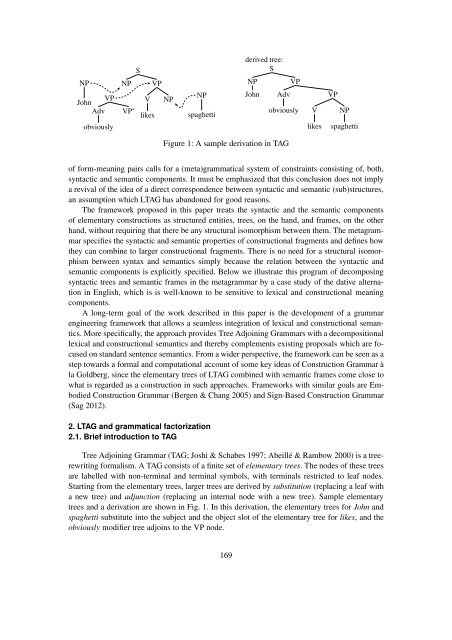Empirical Issues in Syntax and Semantics 9 (EISS 9 ... - CSSP - CNRS
Empirical Issues in Syntax and Semantics 9 (EISS 9 ... - CSSP - CNRS
Empirical Issues in Syntax and Semantics 9 (EISS 9 ... - CSSP - CNRS
Create successful ePaper yourself
Turn your PDF publications into a flip-book with our unique Google optimized e-Paper software.
NP<br />
VP<br />
John<br />
Adv<br />
obviously<br />
S<br />
NP VP<br />
V NP<br />
VP ∗<br />
likes<br />
NP<br />
spaghetti<br />
derived tree:<br />
S<br />
NP<br />
VP<br />
John Adv VP<br />
obviously V NP<br />
likes<br />
spaghetti<br />
Figure 1: A sample derivation <strong>in</strong> TAG<br />
of form-mean<strong>in</strong>g pairs calls for a (meta)grammatical system of constra<strong>in</strong>ts consist<strong>in</strong>g of, both,<br />
syntactic <strong>and</strong> semantic components. It must be emphasized that this conclusion does not imply<br />
a revival of the idea of a direct correspondence between syntactic <strong>and</strong> semantic (sub)structures,<br />
an assumption which LTAG has ab<strong>and</strong>oned for good reasons.<br />
The framework proposed <strong>in</strong> this paper treats the syntactic <strong>and</strong> the semantic components<br />
of elementary constructions as structured entities, trees, on the h<strong>and</strong>, <strong>and</strong> frames, on the other<br />
h<strong>and</strong>, without requir<strong>in</strong>g that there be any structural isomorphism between them. The metagrammar<br />
specifies the syntactic <strong>and</strong> semantic properties of constructional fragments <strong>and</strong> def<strong>in</strong>es how<br />
they can comb<strong>in</strong>e to larger constructional fragments. There is no need for a structural isomorphism<br />
between syntax <strong>and</strong> semantics simply because the relation between the syntactic <strong>and</strong><br />
semantic components is explicitly specified. Below we illustrate this program of decompos<strong>in</strong>g<br />
syntactic trees <strong>and</strong> semantic frames <strong>in</strong> the metagrammar by a case study of the dative alternation<br />
<strong>in</strong> English, which is is well-known to be sensitive to lexical <strong>and</strong> constructional mean<strong>in</strong>g<br />
components.<br />
A long-term goal of the work described <strong>in</strong> this paper is the development of a grammar<br />
eng<strong>in</strong>eer<strong>in</strong>g framework that allows a seamless <strong>in</strong>tegration of lexical <strong>and</strong> constructional semantics.<br />
More specifically, the approach provides Tree Adjo<strong>in</strong><strong>in</strong>g Grammars with a decompositional<br />
lexical <strong>and</strong> constructional semantics <strong>and</strong> thereby complements exist<strong>in</strong>g proposals which are focused<br />
on st<strong>and</strong>ard sentence semantics. From a wider perspective, the framework can be seen as a<br />
step towards a formal <strong>and</strong> computational account of some key ideas of Construction Grammar à<br />
la Goldberg, s<strong>in</strong>ce the elementary trees of LTAG comb<strong>in</strong>ed with semantic frames come close to<br />
what is regarded as a construction <strong>in</strong> such approaches. Frameworks with similar goals are Embodied<br />
Construction Grammar (Bergen & Chang 2005) <strong>and</strong> Sign-Based Construction Grammar<br />
(Sag 2012).<br />
2. LTAG <strong>and</strong> grammatical factorization<br />
2.1. Brief <strong>in</strong>troduction to TAG<br />
Tree Adjo<strong>in</strong><strong>in</strong>g Grammar (TAG; Joshi & Schabes 1997; Abeillé & Rambow 2000) is a treerewrit<strong>in</strong>g<br />
formalism. A TAG consists of a f<strong>in</strong>ite set of elementary trees. The nodes of these trees<br />
are labelled with non-term<strong>in</strong>al <strong>and</strong> term<strong>in</strong>al symbols, with term<strong>in</strong>als restricted to leaf nodes.<br />
Start<strong>in</strong>g from the elementary trees, larger trees are derived by substitution (replac<strong>in</strong>g a leaf with<br />
a new tree) <strong>and</strong> adjunction (replac<strong>in</strong>g an <strong>in</strong>ternal node with a new tree). Sample elementary<br />
trees <strong>and</strong> a derivation are shown <strong>in</strong> Fig. 1. In this derivation, the elementary trees for John <strong>and</strong><br />
spaghetti substitute <strong>in</strong>to the subject <strong>and</strong> the object slot of the elementary tree for likes, <strong>and</strong> the<br />
obviously modifier tree adjo<strong>in</strong>s to the VP node.<br />
169











